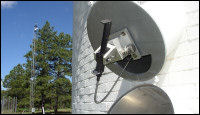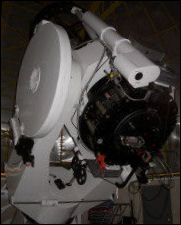The Solar-Stellar Spectrograph: About the SSS Project
[ Home | About | Tech Info & Data | Publications | References ] [ Site by Jeffrey Hall | Research funded by NSF ]

Here's our shady-looking team -- (L-R) Jeff Hall, Wes Lockwood, Brian Skiff (Lowell) and our co-investigator Greg Henry (Tennessee State). Wes, Brian, and I operate the spectrograph from Lowell, while Greg runs the photometric side of the program from TSU and Fairborn Observatory in southern Arizona.
A Brief Timeline
The SSS was built at the High Altitude Observatory in Boulder, CO, in the mid 1980s, and was delivered to Lowell in 1988. Following a funding hiatus from 1989-1992, Co-I Lockwood hired PI Hall in late 1992 under a renewed NSF grant. By that point, the spectrograph hardware control and data aquisition computers were dying and needed to be rebuilt with new machines and new code; we also installed an autoguider and replaced a beamsplitter that introduced debilitating fringing in the red. Regular observations of the Sun and the revised target list began in 1994, and we have been observing steadily since then.
Goals
1. Understand the long term activity of Sun-like stars. Our target list is focused much more tightly on Sun-like stars than Wilson's list. We are specifically interested in characterizing the cycling and (arguably more interestingly) and non-cycling states in the closest solar twins we can find, for direct comparison with our solar data.
2. Improve our understanding of long-term solar brightness variations. With Co-I Henry, we continue long-term monitoring of stellar brightness variations, under the assumption that the envelope of stellar behavior can provide clues as to the likely range of historical solar variations.
3. Communicate our results to the public. Your tax dollars fund the program, after all, so it's essential for us to make our results accessible. Since we tread on the astronomical side of the global warming issue, communication is doubly important. We approach this hot potato with no preconceptions and no agenda; the data are what they are, and we look forward to sharing them with you as this site develops.

Solar Observations
At left is our solar "telescope:" a 200 μm optical fiber that sees the Sun as an unresolved disk. The black cylinder containing the fiber has a standard clock drive to track the Sun at a fixed declination (obviously valid for the brief solar observation time). We average sets of 16 1-second exposures of the Sun to obtain a low-noise solar spectrum for the day, and we typically make three observations per week. The assembly is mounted on the south side of the 1.1-meter telescope dome, and the fiber feeds up to the spectrograph room on the second floor.

Stellar Observations
This is the 1.1-meter John Hall telescope on the top floor of the dome. We make all our stellar observations with this instrument, during bright-time observing runs lasting typically 7-10 nights per month. Depending on the time of year and the observing conditions, we observe anywhere from 20 to as many as 50 stars per night, with exposure times of about ten minutes on a star of V ~ 5.0. Accompanying the target observations are a nightly flat field exposure; we also take periodic biases, darks, and Thorium-Argon calibration spectra to monitor the stability of the instrument. Due to the age of the system, operation is computer-controlled but entirely manual, with an observer required for all telescope slews and observations.
[ Back to my home page | Email me: jch [at] lowell [dot] edu ]
The SSS is publicly funded. Unless explicitly noted otherwise, everything on this site is in the public domain.
If you use or quote our results or images, we appreciate an acknowledgment.
This site is best viewed with Mozilla Firefox.